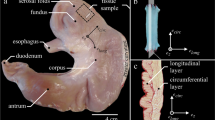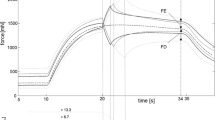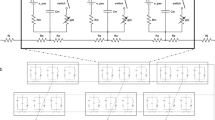Summary
In contrast to striated muscle, measurements on strips of smooth muscle cannot be uniquely interpreted in terms of an array of contractile units. Therefore scaling down to the single-cell level is necessary to gain detailed understanding of the contractile process in this type of muscle. The present study describes the development of a method for isolating contractile single smooth muscle cells from pig urinary bladders. Contractile responses evoked by individual electrical stimulation were used as a measure of cell quality during development of the method. Responses were evaluated by measuring latency, contraction and relaxation times, as indicated by visible length changes, and stored on-line in a computer. Initial length, relative shortening and shortening speed were determined by measuring cell lengths in previously timed still video frames using a computer-controlled crosshair device. Increase of stimulus pulse duration resulted in improved responses, indicating that the observed shortening represented a physiological contractile response. Ultimately this method of evaluation was applied to two sets of cell preparations obtained by two different methods, one using only collagenase digestion, the other using mechanical manipulation as well. Both sets showed two main patterns of response to electrical stimulation: a pattern of contraction upon stimulation followed by enhanced contraction when stimulation was switched off (CK), and a pattern of contraction upon stimulation followed by relaxation when the stimulus was switched off (CR). The set of preparations containing the highest percentage of CR cells was found to be superior (i.e. greater initial length, shorter latency and contraction times, increased shortening and higher shortening speed). The method of isolation used for this set gives a high yield of contractile cells available for experimental use over a long span of time.
Similar content being viewed by others
References
Bagby, R. M. (1974) Time course of isotonic contraction in single cells and muscle strips fromBufo marinus stomach.Am. J. Physiol. 227, 789–93.
Carle, D. J. de,Christensen, J., Szabo, A. C., Templeman, D. C. &Mckinley, D. R. (1977) Calcium dependence of neuromuscular event in esophageal smooth muscle of the opossum.Am. J. Physiol. 232, E547–52.
Chamley-Campbell, J. H. &Campbell, G. R. (1981) What controls smooth muscle phenotype?Atherosclerosis 40, 347–57.
Chamley-Campbell, J., Campbell, G. R. &Ross, R. (1979) The smooth muscle cell in culture.Physiol. Rev. 59, 1–42.
Cowan, W. D. &Daniel, E. E. (1983) Human female bladder and its noncholinergic contractile function.Can. J. Physiol. Pharmacol. 61, 1236–46.
Douglas, W. R. (1972) Of pigs and men and research.Space Life Sci. 3, 226–34.
Duyl, W. A. van (1985) Spontaneous contractions in urinary bladder smooth muscle: Preliminary results.Neurol. Urodyn. 4, 301–7.
Dijk, A. M. van,Wieringa, P. A., Meer, M. van der &Laird, J. D. (1984) Mechanics of resting isolated single vascular smooth muscle cells from bovine coronary artery.Am. J. Physiol. 246 (Cell Physiol. 15), C277-C287.
Fay, F. S. (1977) Isometric contractile properties of single isolated smooth muscle cells.Nature, Lond. 265, 553–6.
Fay, F. S., Cooke, P. H. &Canady, P. G. (1976) Contractile properties of isolated smooth muscle cells. InPhysiology of Smooth Muscle (edited byBulbring, E. andShuba, M. F.), pp. 249–64. New York: Raven Press.
Fox, J. A. &Daniel, E. E. (1979) Role of Ca2+ in genesis of lower esophageal sphincter tone and other active contractions.Am. J. Physiol. 237, El63–71.
Glerum, J. J., Pino, E. A. &Mastrigt, R. van (1986) A low cost computer-controlled asynchronous-video cross-hair device.Med. Biol. Eng. Comput. Submitted for publication.
Hellstrand, P. (1979) Mechanical and metabolic properties related to contraction in smooth muscle.Acta Physiol. Scand. Suppl. 464, 1–54.
Hong, K. W., Biancani, P. &Weiss, R. M. (1985) ‘On’ and ‘Off’ responses of guinea pig ureter.Am. J. Physiol. 248, C165–9.
Ince, C., Ypey, D. L., Diesselhoff-Den Dulk, M. M. C., Visser, J. A. M., Vos, A. de &Furth, R. van. (1983) Micro-CO2-incubator for use on a microscope.J. Immun. Meth. 60, 269–75.
Ishii, N. &Takahashi, K. (1982) Length-tension relation of single smooth muscle cells isolated from the pedal retractor muscle ofMytilus edulis.J. Musc. Res. Cell Motility 3, 25–38.
Kinder, R. B. &Mundy, A. R. (1985) Atropine blockade of nerve-mediated stimulation of the human detrusor.Br. J. Urol. 57, 418–21.
Mastrigt, R. van &Glerum, J. J. (1985a) Electrical stimulation of smooth muscle strips from the urinary bladder of the pig.J. biomed. Eng. 7, 2–8.
Mastrigt, R. van &Glerum, J. J. (1985b)In vitro comparison of isometric and stop-test contractility parameters for the urinary bladder.Urol Res. 13, 11–17.
Mastrigt, R. van &Griffiths, D. J. (1979) Contractility of the urinary bladder.Urol. Int. 34, 410–20.
Mastrigt, R. van &Griffiths, D. J. (1986) An evaluation of contractility parameters determined from isometric contractions and micturition studies.Urol. Res. 14, 45–52.
Meiss, R. A. (1975) Graded activation in rabbit mesotubarium smooth muscle.Am. J. Physiol. 229, 455–65.
Murphy, R. A. (1976) Contractile system function in mammalian smooth muscle.Blood Vessels,13, 1–13.
Obara, K. (1984) Isolation and contractile properties of single smooth muscle cells from guinea pig taenia caeci.Jap. J. Physiol. 34, 41–54.
Papasova, M., Gachilova, S. &Mizhorkova, Z. (1981) Analysis of the innervation of the gastroduodenal region.Acta Physiol. Pharmacol. Bulg. 7, 3–9.
Sibley, G. N. A. (1984) A comparison of spontaneous and nerve-mediated activity in bladder muscle from man, pig and rabbit.J. Physiol, Lond. 354, 431–43.
Sjogren, C., Andersson, K., Husted, S., Mattiasson, A. &Moller-madsen, B. (1982) Atropine resistance of transmurally stimulated isolated human bladder muscle.J. Urol. 128, 1368–71.
Small, J. V. (1977) Studies on isolated smooth muscle cells: The contractile apparatus.J. Cell Sci. 24, 327–49.
Thüroff, J. W., Bazeed, M. A., Schmidt, R. A., Luu, D. J. &Tanagho, E. A. (1983) Cultured rabbit vesical smooth muscle cells for lining of dissolvable synthetic prosthesis.Urology,21, 155–8.
Thüroff, J. W., Bazeed, M. A., Schmidt, R. A. &Tanagho, E. A. (1982) Drug-induced responses of canine vesical smooth muscle cells in cultures.Neurol. Urodyn. 1, 233–8.
Author information
Authors and Affiliations
Rights and permissions
About this article
Cite this article
Glerum, J.J., Van Mastrigt, R., Romijn, J.C. et al. Isolation and individual electrical stimulation of single smooth-muscle cells from the urinary bladder of the pig. J Muscle Res Cell Motil 8, 125–134 (1987). https://doi.org/10.1007/BF01753988
Received:
Revised:
Issue Date:
DOI: https://doi.org/10.1007/BF01753988




